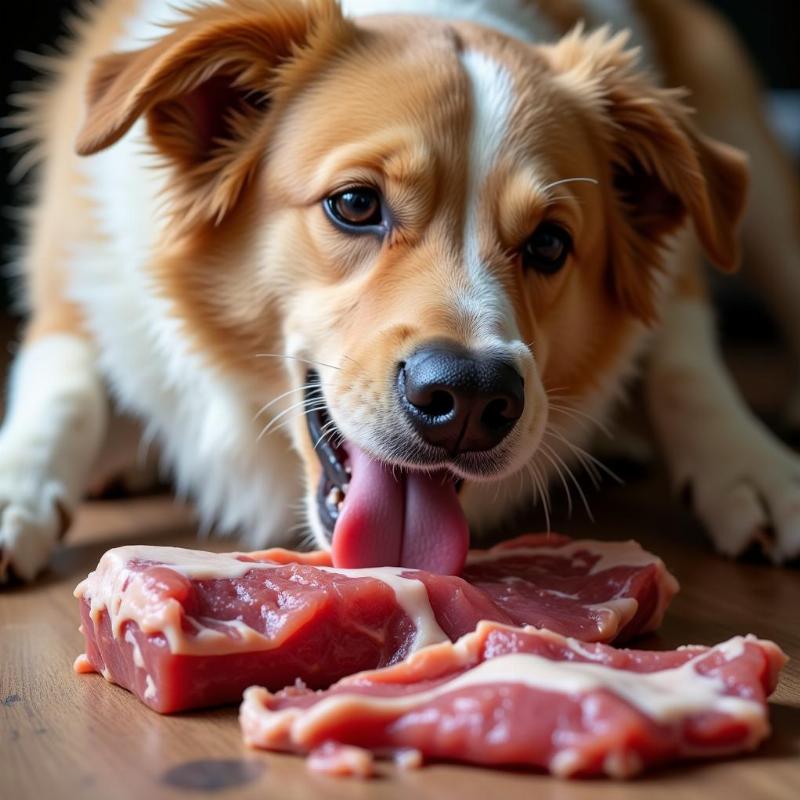Raw dog food diets are increasingly popular in the US, with many pet owners believing they offer numerous health benefits. “All provide raw dog food” suggests a search for comprehensive information on this feeding method, covering various aspects, including benefits, risks, and practical implementation. Let’s delve into the world of raw feeding and explore if it’s the right choice for your canine companion.
Understanding the Raw Dog Food Diet
A raw dog food diet typically consists of uncooked muscle meat, organs, bones, and sometimes fruits and vegetables. Proponents believe it mimics the diet of wild canids and offers benefits like improved coat health, increased energy, and better digestion.  A dog eating raw meat However, it’s crucial to understand the nuances of this feeding approach before making the switch.
A dog eating raw meat However, it’s crucial to understand the nuances of this feeding approach before making the switch.
Benefits and Risks of a Raw Diet
While raw feeding can offer advantages, it also presents potential risks. Improved dental health due to the abrasive action of chewing bones is often cited as a benefit. Some owners also report shinier coats and increased energy levels in their dogs. However, raw diets carry the risk of bacterial contamination, such as Salmonella and E. coli, which can affect both dogs and humans. Nutritional imbalances are also a concern if the diet isn’t carefully formulated.
Is Raw Feeding Right for Your Dog?
The decision to feed your dog a raw diet should be made in consultation with your veterinarian. Factors like your dog’s age, breed, and health status should be considered. Puppies and senior dogs, or those with compromised immune systems, may be more susceptible to the risks associated with raw feeding. k9 kraving raw dog food
Creating a Balanced Raw Dog Food Meal
If you choose to feed raw, meticulous planning is essential to ensure your dog receives all necessary nutrients. A balanced raw diet typically includes muscle meat, organ meat (like liver and kidney), bones, and a small portion of fruits and vegetables. Supplements may also be necessary to address potential nutrient deficiencies. wild harvest dog food reviews Consulting a veterinary nutritionist is highly recommended to create a personalized meal plan tailored to your dog’s specific needs.
Safe Handling Practices for Raw Dog Food
Handling raw meat requires strict hygiene to prevent bacterial contamination. Wash your hands thoroughly after handling raw food, and sanitize all surfaces that come into contact with it. Use separate cutting boards and utensils for raw meat and human food. keep dogs off flower beds] Store raw food properly in the freezer and thaw it safely in the refrigerator.
Transitioning Your Dog to a Raw Diet
Switching your dog to a raw diet should be done gradually to avoid digestive upset. Start by introducing small amounts of raw food alongside their current diet, slowly increasing the proportion of raw food over several days or weeks. Monitor your dog closely for any signs of digestive issues, such as vomiting or diarrhea. best food for portuguese water dog]
Addressing Common Concerns About Raw Feeding
Many pet owners have concerns about the cost and time commitment involved in raw feeding. While it can be more expensive than commercial kibble, sourcing ingredients in bulk and preparing meals in advance can help manage costs. sonic footlong hot dog menu] “Dr. Emily Carter, a veterinary nutritionist based in California, advises, ‘Raw feeding can be a rewarding experience, but it requires diligent research and preparation to ensure your dog’s nutritional needs are met.’”
Conclusion
“All provide raw dog food” encapsulates the need for comprehensive information on this feeding method. Raw feeding can be a viable option for some dogs, but it’s crucial to weigh the benefits and risks carefully. Consult your veterinarian, do thorough research, and prioritize safe handling practices to make informed decisions about your dog’s nutrition.
FAQ
- Is raw food safe for puppies? Puppies have developing immune systems and may be more susceptible to bacterial infections from raw food. Consult your vet before feeding raw to a puppy.
- What are the signs of a nutritional deficiency in a raw-fed dog? Signs can include dull coat, lethargy, weight loss, and digestive issues.
- Where can I source high-quality ingredients for a raw diet? Local butchers, farmers’ markets, and reputable online suppliers can be good sources.
- Can I mix raw food with kibble? While some owners do this, it’s not generally recommended as it can lead to digestive imbalances.
- How often should I feed my dog a raw diet? Most adult dogs thrive on being fed once or twice a day.
Beautdogs.us is your trusted source for comprehensive dog care information. We offer expert advice on dog breeds, nutrition, and all aspects of dog ownership. Whether you’re a seasoned dog owner or just starting out, Beautdogs.us provides valuable insights to help you navigate the world of canine companionship. Contact us today at [email protected] or call us at +1 501-555-7529. We’re here to help you provide the best possible care for your furry friend!